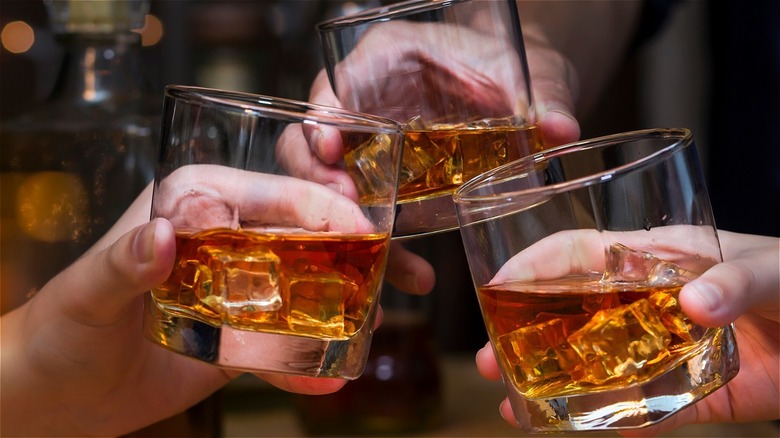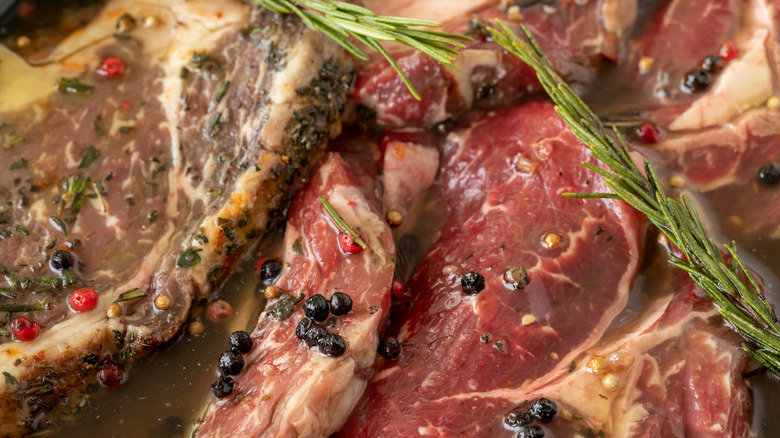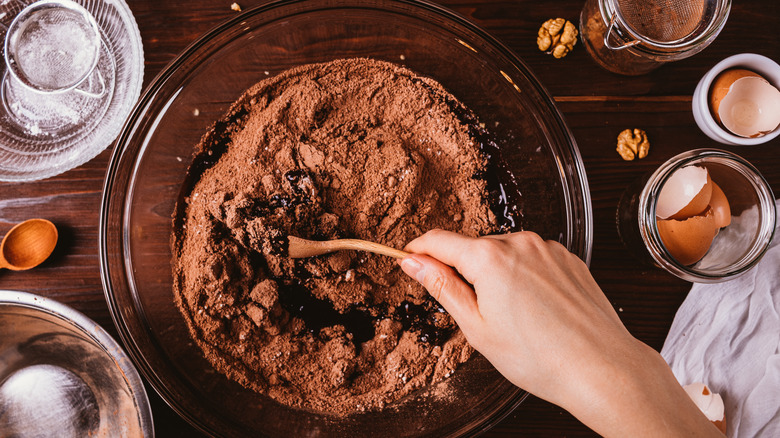The Real Reason Bourbon Makes The Perfect Marinade
When Mark Twain supposedly said, "Too much of anything is bad, but too much good whiskey is barely enough" (via The Manual), it's not likely he was opening a bottle of bourbon to marinade a rib-eye steak. But, that would have been delicious.
Bourbon is a type of whiskey, known for its mature, rich essence. That signature bourbon experience happens without any additives or artificial flavors. Bourbon is developed by way of new charred oak barrels and a meticulous, inviolable process of production that people take very, very seriously.
Bourbon is singularly produced in the United States, made official by a resolution Congress passed in 1964. It is distilled from a grain mix that must be at least 51% corn, and it cannot be higher than 62.5% alcohol going into the barrel, where it must be aged at least two years, says Bull and Bourbon. What will all that do for our food if we cook with it? It will do a lot, and most of it will be beautiful.
Tenderizer, marinades, and sauces, oh my
Bourbon has smoky notes that make it a great marinade, plus (via Indiana Public Media's A Moment of Science) it breaks down the enzymes in meat, giving your steak a natural tenderizer. The marinade itself can be a combo of sweet and savory by adding brown sugar to the mix, or soy sauce and Worcestershire sauce and your choice of herbs or spices, like ginger and other condiments — perhaps a pungent Dijon or honey mustard. Whatever your marinade, the bourbon will complement what you're making plus add hints of its own oak-aged essence.
Liquor.com suggests that rather than tossing out your finished marinade, simmer it down to a thickened sauce, or you can make a bourbon sauce from scratch starting with those glorious caramelized bits that are left in the pan after searing and cooking your steak. Start your basic build of a bourbon sauce by pouring a liberal cup of bourbon onto your hot pan after you've removed the meat, then simmer it into syrup, adding cream or a soup stock, depending on the kind of sauce you want.
Bourbon base sauces are not limited to meat entrées, and particular bourbons can bring out particular flavors. A "wheated" Maker's Mark, for instance, presents sweet and therefore boosts dessert sauces and jams, or a "high-rye" Four Roses Single Barrel trends on the bright side and so complements dressings. A malted barley goes best with breads or creamy pastas.
Baking with bourbon
Bourbon is an intense flavor. It is generally sweeter thanks to corn, spicier thanks to rye, and bready, thanks to malted barley (per Kentucky Bourbon). Yeast delivers a pendulum swing, from a nutty to a fruity element. So how do we translate that into tasty baking with bourbon without it just landing boozy?
Start with the right bourbon-recipe pairing, says Distillery Groove. Although flavors come down to personal preference, there are flavor profiles that can get us started. Toasted pecans mixed with caramel filling and a smokey bourbon makes a great pie (via Energex), or dark chocolate with spices, maple notes and a beautiful bourbon makes bread pudding richer, sweeter, better.
No need to go broke on baking with bourbons that are best sipped and savored in a glass rather than in your pie dough. However, high quality always counts, so some good go-to baking bourbons include Jim Beam and Knob Creek. Proof counts, too, especially considering the precise timing required to bake anything light, flaky, and fluffy. Keep in mind that higher proof bourbons will take longer to burn off their alcohol, which means you'll need longer, slower baking times to squeeze that vanilla sweetness out of your bourbon add-in, says Energex. Higher proof bourbons also congeal and thicken faster, which is bad news for your dessert cream if you add it to the dish too early. So, consider flavor profiles, watch the proof, and don't settle – if you wouldn't drink it, don't bake with it.


